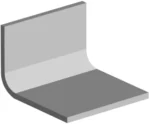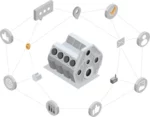Overview of the different welding processes
On this page you will find an overview of the most common welding processes.
Choosing the right welding process requires distinguishing between different workpiece requirements, such as material thickness, accuracy, or cost.
In the meantime, three types of fusion welding have become particularly established: TIG welding, MIG welding and MAG welding.

MIG welding
Inert gas welding (MIG) is an arc welding process in which a continuously fed welding wire acts as both electrode and filler material. An electric arc is formed between the wire and the workpiece, melting and joining the two materials. To protect the electric arc and the weld pool from atmospheric influences such as oxygen and moisture and thus prevent oxidation, argon or helium is usually used as the inert shielding gas.
A MIG welding system consists of several essential components: a power source that provides the welding current, a wire feed mechanism that continuously supplies the welding wire, a hose assembly with a welding torch that brings the wire and gas to the welding area, and a gas supply unit for supplying the shielding gas.
A wide variety of metals, especially non-ferrous metals such as aluminum and copper, can be welded with MIG welding, allowing for high welding speeds and clean welds with minimal rework. The process is also easy to automate and results in minimal welding distortion.
Since the shielding gas can be easily dispersed by the wind, which affects the welding quality, it has the disadvantage of being susceptible to wind and rust. For this reason, MIG welding is not suitable for outdoor use. It is also essential that the workpiece surface be clean, as impurities can affect the welding quality.
MAG welding
Metal-gas arc welding (MAG) is an arc welding process in which a continuously fed welding wire acts as the electrode and filler material. An electric arc is formed between the workpiece and the wire electrode, causing the two materials to melt and bond. The electric arc and the weld pool are surrounded by an active shielding gas, which is usually carbon dioxide (CO2) or mixed gases of argon with CO2 or oxygen. It protects them from atmospheric influences and has a targeted influence on the welding properties.
A MAG welding system consists of several main components: a power source that generates the welding current, a wire feed mechanism that continuously supplies the welding wire, a hose assembly with a welding torch that brings the wire and gas to the welding zone, and a gas supply unit for the shielding gas.
The versatility of MAG welding is one of its strengths, especially for processing steels with different alloys. It allows for high welding speeds and ensures reliable and strong welds, which can also have an attractive visual appearance. This process is extremely popular in industry due to its compatibility with different material thicknesses and its automation capability.
However, MAG welding can be affected by external factors such as wind, as the shielding gas can be dispersed, which has a negative effect on the quality of the welds. In addition, the surface of the workpiece must be carefully prepared, as contamination can have a negative effect on the welding results. These limitations make the process less suitable, especially for outdoor applications.
TIG welding
Tungsten inert gas (TIG) welding is a fusion welding process that uses a non-consumable tungsten electrode. An electric arc is formed between this electrode and the workpiece, melting the material. An inert shielding gas, usually argon or helium, surrounds the welding area and protects it from atmospheric influences such as oxygen and moisture to prevent oxidation and other chemical reactions.
A typical TIG welding system consists of a power source for the welding current, a hose assembly with a welding torch including the tungsten electrode and gas supply, a gas supply unit for the shielding gas, and a ground cable to form the electrical circuit. Manual addition of filler material is optional, especially for thicker materials or special applications.
TIG welding has the advantage of being able to weld almost any metallic material, including thin sheet metal and gas-sensitive metals such as titanium. This process produces high-quality, clean, spatter-free welds with high strength and good surface finish. TIG welding can also be used in any position and is well-suited to mechanized processes, such as orbital tube welding.
This process is less economical for thicker materials due to the relatively slow welding speed and higher energy consumption. In addition, TIG welding requires considerable skill and experience on the part of the welder, especially when manually feeding the filler metal. TIG welding equipment often requires a higher initial investment compared to other welding processes, and the process is less suitable for environments with dust or fumes.
Laser welding
Laser welding, a high-precision process, involves joining materials using a concentrated laser beam as a heat source. Over a small area, the laser beam generates a high energy density, resulting in local melting of the material and the formation of a weld bead. To protect the weld pool from oxidation and impurities, a shielding gas, usually argon or helium, is used.
Laser welding systems typically consist of a laser source (such as a CO₂ laser or a solid-state laser), a beam guidance system, focusing optics, a workpiece holder, and a gas supply unit for the shielding gas. These elements work together to precisely align the laser beam with the welding point and enable controlled welding.
Advantages of laser welding include, for example, high welding speeds, low thermal deformation of the workpiece, precise control of welding parameters, and the ability to join different materials. In addition, this process allows for deep, narrow welds with high strength.
The disadvantages include the high cost of purchasing laser systems and the need for special protective measures due to the intensity of the laser radiation. In addition, the process requires precise positioning of the workpieces and is sensitive to material reflections, which can affect the quality of the weld.
Gas welding
Gas welding, also known as autogenous welding, is a thermal welding process. In this case, the heat required to fuse materials is produced by the combustion of a fuel gas with oxygen. Acetylene is typically used as the fuel gas because, in combination with oxygen, it reaches a flame temperature of approximately 3,200 °C, sufficient to melt most metals. The welder has complete control over the welding process by manually guiding the resulting electric arc. This advantage makes the process particularly suitable for applications requiring precision.
A gas welding system consists of several main components: two gas cylinders (one for oxygen and one for fuel gas), regulators to regulate gas pressure, gas supply hoses, a welding torch to mix and ignite the gases, and anti-return devices to prevent flashbacks. In addition, different nozzle shapes can be used to adapt the flame focus to different parts and applications. This flexibility makes the process particularly popular for repair applications and thin sheet metal.
The advantages of gas welding include its mobility and versatility, since no power source is required. It is particularly suitable for repair work, for which the welding machine can be used independently of a power source. In addition to welding, brazing and cutting work can also be carried out, making this process indispensable in many workshops.
However, the disadvantages are the slow welding speed and the risk of thermal distortion (misalignment of the welding position) due to the high heat spread. Using a gas cylinder requires strict safety measures due to the risk of breakdown and explosion. In addition, operating costs are higher than with other processes due to higher gas consumption. The environmental impact of burning acetylene is also a disadvantage. Due to these factors, this process is not suitable for large industrial uses.
Further welding processes
Stud welding
Stud welding is a process of welding rod-shaped metal parts, such as threaded studs or weld pins, to metal parts. This process is suitable for unalloyed and alloyed steel materials as well as aluminum and aluminum alloys.
Advantages
- High cost-effectiveness thanks to short welding times.
- Accessibility from one side of the room is sufficient.
- High strength of the welded assembly.
Disadvantages
- Limited material thicknesses and bolt diameters.
- Requires special equipment and bolts.
- Surface preparation of the workpiece is necessary.
Electric hand welding (E-hand welding)
E-Hand welding, also known as hand arc welding, is a welding process that uses a coated electrode rod. This electrode serves as both an arc source and a filler material. During welding, the electrode coating melts and forms a protective layer that protects the weld pool from external influences such as oxygen and moisture. This process is suitable for unalloyed, low-alloy, and high-alloy steels, as well as other metals.
Advantages
- Versatile, it can be used for different materials.
- Can be used in all welding positions
- Reduced welding environment requirements - can also be used outdoors.
- Economical and simple equipment.
Disadvantages
- Relatively low welding speed compared to automated processes.
- Requires manual skills and experience.
- Slag must be removed after welding.
- Less suitable for thin sheet metal or high precision applications.
Submerged arc welding (SAW)
Submerged arc welding (SAW) is an automated arc welding process in which the electric arc is concealed under a layer of granular welding powder. This powder protects the electric arc and the weld pool from atmospheric influences, while providing chemical additives that improve weld quality. This process is particularly suitable for thick-walled workpieces and is often used for processing unalloyed, low-alloyed, and high-alloyed steels.
Advantages
- High welding speed and efficiency, especially for long, straight welds.
- Excellent welding quality thanks to the protection of the welding powder.
- Low welding distortion due to uniform heat application.
- Ideal for thicker materials and large projects, for example in shipbuilding or pressure vessels.
- The possibility of automation allows for high reproducibility.
Disadvantages
- Limited flexibility: the process is less suitable for complex geometries or positions.
- High initial investment in equipment and automation.
- Suitable only for horizontal or slightly inclined welds.
- Requires careful preparation of parts and careful selection of welding powder.
- Powder residue must be removed after welding, which is additional work.
Resistance welding
Resistance welding is a thermal welding process in which heat is generated by electrical resistance and the resulting current flow between two workpieces. Under pressure, the workpieces are pressed together, and the pinpoint heat creates a strong bond. It is often used for unalloyed and low-alloy steels as well as aluminum.
Advantages
- Very fast welding times and high degree of automation.
- No additional consumables are required, such as welding wire or shielding gas.
- High repeatability and quality of welding points.
- Ideal for mass production, for example in the automotive industry.
Disadvantages
- Limited applicability for thicker materials.
- High initial investment in welding equipment.
- Requires fine tuning of settings for optimal results.
- More difficult for complex geometries or uneven parts.
Further manufacturing processes
Our blog
Book personal meeting
Contact us now
* By submitting the form, you agree to the assemblean privacy policy.











